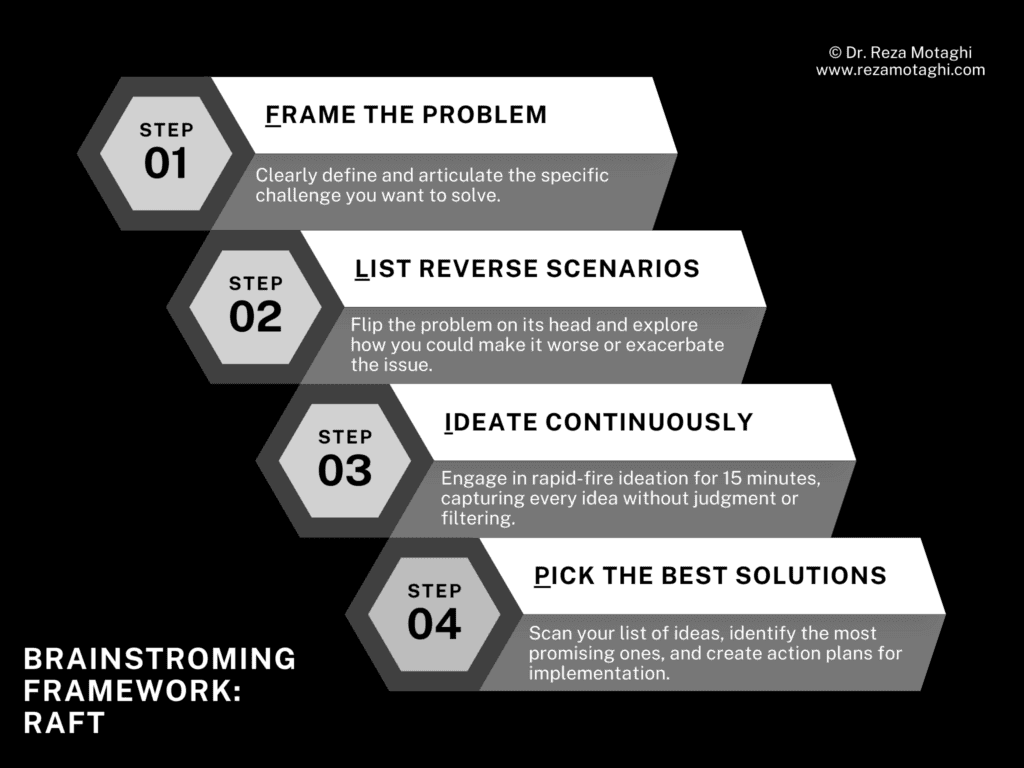Brainstorming for Solvers: How to Crack Tough Problems on Your Own

Why Solo Brainstorming Feels Broken—And How to Fix It
You’ve been there before—staring at a blank page, stuck, waiting for a solution to your problem that never seems to come.
You need ideas, but they just aren’t flowing. It’s frustrating. You’re on your own, and without a team to bounce ideas off, it feels like solo brainstorming is trapped in a loop.
Brainstorming isn’t waiting for lightning to strike. It’s creating your own storm.
In innovation-driven fields, it’s a non-negotiable mental workout. It’s on the schedule, and after an hour, your brain is firing on all cylinders, even if you’re exhausted.
That’s how you know it worked.
Now, you might be thinking, “That’s great for big companies, but I’m solo. How does this apply to me?”
Here’s the truth: The principles that make corporate brainstorming effective can become powerful creative problem solving techniques for solopreneur problem solving.
With the right framework, you can replicate the power of team ideation, even when you’re flying solo.
Moreover, studies have shown that individuals working alone can generate more ideas than groups in traditional brainstorming sessions.
The key elements are:
- A rock-solid structure
- Time-tested frameworks (think SCAMPER or Six Thinking Hats)
- Laser-focused coordination
These aren’t just for boardrooms. They’re tools you can adapt to turbocharge your solo ideation sessions.
Let’s be real: As a solopreneur, your perception of brainstorming might be a bit… off.
You’ve probably tried it before—sitting down with a blank page, hoping for a flood of brilliant ideas.
You get distracted. You hit mental roadblocks. You veer off course.
You end up with a scattered mess of thoughts that lead nowhere.
It’s no wonder you’ve written off brainstorming as a waste of time. A fluffy exercise that sounds good in theory but falls flat in practice.
You’re leaving opportunities on the table.
The very essence of solo entrepreneurship is problem-solving. Every day, you’re up against challenges that demand innovative solutions. And let’s face it, in this game, one good solution can be the difference between thriving and barely surviving.
This is where effective brainstorming becomes your superpower.
The irony? Solo entrepreneurs—the ones who could benefit most from structured ideation—are often the least likely to use it properly.
Why? Because everybody is whispering brainstorming but no one’s shown you how to do it right.
It’s time to flip the script on solo brainstorming. Let’s turn that blank page from your nemesis into your most powerful ally in business and life growth.
How about a framework designed specifically for ambitious solopreneurs like you? One that will transform your approach to problem-solving and creativity.
From that initial spark of an idea to the nitty-gritty of product distribution, effective brainstorming can be your ace in the hole.
The FLIP Framework: A Guide to Solo Brainstorming
Drawing from my experience in the Innovation field in corporate settings, I developed the FLIP Framework—a practical tool designed to address the unique challenges solopreneurs face.
Here’s what FLIP stands for:
F – Frame the problem
L – List reverse scenarios
I – Ideate continuously
P – Pick the best solutions
Grab these essentials:
- A timer (set it for 30-45 minutes)
- Pen and paper (or your favorite digital note-taking tool)
Pro tip: Commit to the full session, even if you think you’ve struck gold early on. Trust me, some of your best ideas might be lurking in those final minutes.
Need to prime your mind? Try a focused creativity walk before starting.
Let’s start:
Step 1: Frame the Problem
Ever feel like you’re swinging at shadows? That stops now.
Take your challenge and pin it down on paper. Make it concrete. Specific. Tangible.
Why? Because your brain loves clarity. The more real your problem becomes, the more fired up your mind gets to solve it.
So, at the top of your page, write out your challenge in crystal-clear terms. No vagueness allowed.
For example:
“How can I increase my website’s monthly recurring visitors by 50% in the next quarter?”
Step 2: List Reverse Scenarios
Now, we’re going to flip your problem on its head.
Instead of asking how to solve it, we’re going to explore how to make it worse.
Yes, you read that right.
Why? Because this counter-intuitive approach unlocks a treasure trove of insights you’d never reach by conventional thinking.
Let’s break it down:
- Take your framed problem and reverse it.
- Ask yourself: “How could I amplify this issue?”
Using our example:
“How could I drive visitors away from my website and ensure they never return?”
Step 3: Ideate Continuously (15 Minutes of Controlled Chaos)
”The best way to have a good idea is to have lots of ideas.” – Linus Pauling
Now, we’re diving into the heart of the FLIP Framework: rapid-fire ideation.
Grab your pen and paper. Set your timer for 15 minutes. We’re about to unleash a torrent of ideas.
Here’s how it works:
- Start with your reverse scenario. This is your launchpad.
- Begin writing immediately. No pauses. No second-guessing.
- Keep that pen moving (or those fingers typing) non-stop.
- Use shorthand. Keywords are your friends.
- New idea? Slash (/) the previous and keep going.
- Push through for the full 15 minutes.
The Rules of the Game:
- Every idea gets written down. Yes, even the wild ones.
- Forget grammar. Ignore spelling. Punctuation who?
- No editing. No judging. Just pure, unfiltered ideation.
- Embrace the tangents. That’s where the gold often hides.
Stuck? No problem. Start jotting down industry-related buzzwords, product features, or customer types. Something will spark.
Let’s see it in action:
Problem: “How to boost website engagement?”
Reverse: “How could I drive visitors away from my website?”
Ideation: Broken links everywhere / auto-play annoying music / pop-ups every 5 seconds / unreadable font / hide navigation / turtle-speed loading / pushy sales assault / no contact info / constant redirects / ad apocalypse / outdated and broken design / forms with too many fields /{I feel out of ideas, writing some generic industry related words non stop}…keyboard, mouse, click, click, click/ clickbait titles with no value / unoptimized images and videos slowing down page load times /{stuck again}…laptop…mobile, mobile/ bad mobile optimization / video background seizure / force users to log in before seeing any content / security red flags / a lot of typos / no search functionality / hard-to-find product or service pages / checkout labyrinth / brand identity crisis / animation overload / false promise parade / no social proof or testimonials / no clear calls-to-action /FINISH.
Remember: Quantity trumps quality here. Every idea, no matter how outlandish, is a potential goldmine when refined later.
The 15-minute time crunch is your friend. It silences your inner critic and pushes you to generate ideas at warp speed.
When that timer dings, stop immediately. Resist the urge to add “just one more.” Take a deep breath. You’ve just completed an idea-generating marathon.
This stage’s technique is inspired by Matthew Dicks’ slash-and-burn freewriting brilliant method from his book Storyworthy, but it’s been modified to suit brainstorming and creative problem-solving.
Step 4: Pick Your Power Plays (5 Minutes of Focused Selection)
You’ve just unleashed a storm of ideas. Now it’s time to find the lightning.
Set your timer for 5 minutes. We’re shifting gears from quantity to quality.
Here’s your gameplan:
- Scan your list. Don’t linger, just absorb.
- Circle or highlight ideas that make you pause. Trust your gut.
- Narrow it down to your top 3-5 contenders.
- For each chosen idea, jot down a quick action plan. Think bullet points, not essays.
Remember, we’re looking for ideas that are:
- Impactful: Could this move the needle?
- Feasible: Can you realistically implement this?
- Innovative: Does this approach things from a fresh angle?
Congratulations! You’ve just completed your first FLIP brainstorming session. You now have a handful of golden ideas ready for action.

From Chaos to Clarity
This isn’t a one-and-done deal. The FLIP Framework is your new power tool, ready to deploy whenever you face a business challenge.
After your session, clear your head with an 8-bit game break before reviewing your ideas.
The FLIP Framework isn’t just for business—it’s equally effective for personal challenges. Whether you’re planning a unique vacation or solving a family dispute, FLIP can help you approach the problem from fresh angles.
Brainstorming about a failed project? The RAFT framework can help you extract valuable insights first.
And like any skill, the more you flex this muscle, the stronger it gets. Each session will become more fluid, more productive, more innovative.
So, what are you waiting for?
That nagging problem you’ve been avoiding? It’s time to flip it on its head.
Grab your pen. Set your timer. And prepare to be amazed at the creative force you’re about to unleash.
Your next breakthrough idea is just 30 minutes away. Let’s make it happen.
Frequently Asked Questions
What is the FLIP Framework?
A: FLIP stands for Frame, List, Ideate, Pick. It’s a 30-minute solo brainstorming method that helps you generate creative solutions alone. Frame your problem, list reverse scenarios, ideate for 15 minutes straight, then pick your best ideas.
How long should I brainstorm alone?
A: 30-45 minutes total. The core ideation phase is just 15 minutes of non-stop writing. This prevents mental fatigue while giving you enough time to breakthrough obvious solutions and find creative ones.
Does solo brainstorming actually work?
A: Yes. Research shows individuals generate more ideas alone than in groups. You avoid groupthink, social pressure, and dominant personalities that kill creativity in meetings.
What’s the reverse scenarios technique?
A: Instead of solving your problem directly, ask “How could I make this worse?” Then flip those ideas into solutions. If you want more website traffic, first brainstorm how to drive visitors away, then reverse each idea.
What if I run out of ideas during brainstorming?
A: Keep writing anyway. When stuck, write random industry words, customer types, or features. Use slash marks (/) between ideas. The best solutions often come when you think you’re empty.
What supplies do I need for solo brainstorming?
A: Just pen, paper, and a timer. Set 30-45 minutes and commit to the full session. Digital notes work too, but handwriting often sparks different creative connections.
Should I judge my ideas while brainstorming?
A: No. Write everything down, even crazy ideas. Wild concepts often contain breakthrough solutions. Save judgment for the “Pick” phase – during ideation, quantity beats quality.
Why not just use regular group brainstorming?
A: Group brainstorming often fails due to social dynamics, loudest voices winning, and fear of judgment. Solo brainstorming gives you complete creative freedom and proven better results for idea generation.






